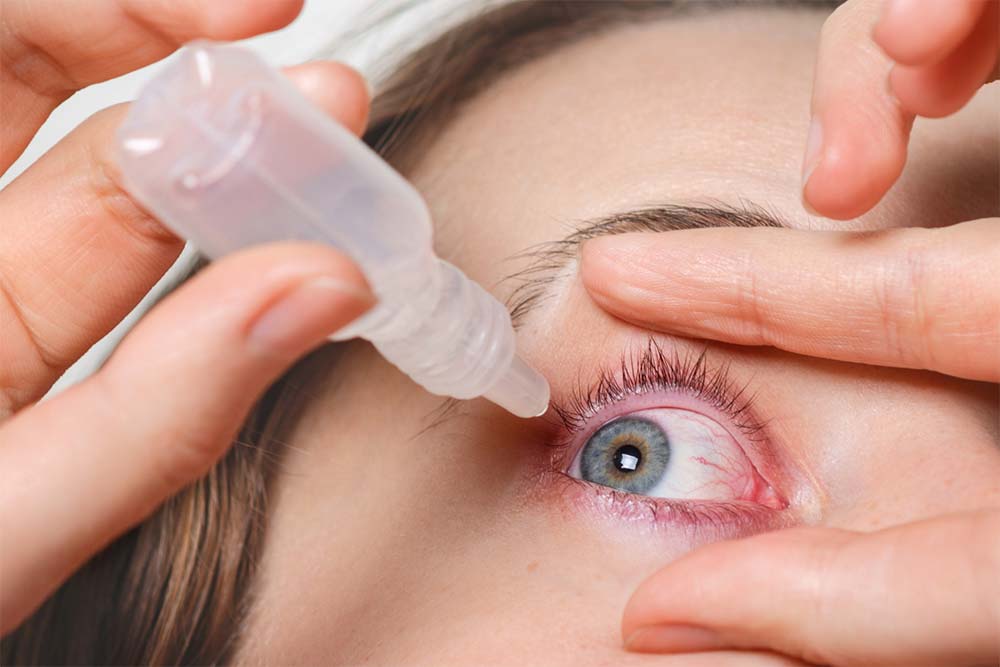Contact Lens Induced Dry Eye (CLIDE), also known as Dry Eye Syndrome (DES), is a common eye disorder for which there are effective treatments. About 3.4 million adult Americans suffer from this condition. Symptoms include itchy, watery, or red eyes, sensitivity to light, blurry vision, and eye pain.
Contact lens wearers are especially prone to this condition. One cause of the disease is continuous contact with artificial materials (such as contact lenses and eyeglass lenses), which absorb moisture, thereby reducing the natural evaporation of tears from the eye. Another cause is the wearing of ill-fitting contact lenses, which can allow bacteria or other irritants to enter your eyes.
The Contact lens induced dry eye is an eye condition caused by wearing contact lenses most often at night. If left untreated, it can lead to significant vision loss. Contact lens induced dry eye occurs when the eye is deprived of oxygen and becomes inflamed.
Contact Lens Induced Dry Eye occurs when the eye cannot produce enough tears to keep the eye moist (without constant artificial tears). This could be due to an autoimmune disorder or certain medications. Contact Lens Induced Dry Eye is usually treated with artificial tears and eye drops. If you’re looking for additional treatment options for Dry Eye, you can check out dry eye clinical trials at Power.
How does Contact Lens cause by Dry Eye?
Dry eye, also known as keratoconjunctivitis sicca, is a common eye disorder that can, in some people, cause discomfort and possible loss of vision. The condition is the result of a deficiency of the tear film, which lubricates and protects the eyes. The film is produced by the meibomian glands, tiny glands that produce oil to lubricate the eye. Normally, meibomian glands produce a clear, oily lubricant that coats the eye’s outermost layer of cells.
Dry eye is an inflammation of the ocular surface that results in discomfort, blurred vision, and other symptoms. Contact lenses can worsen the dryness, so patients with dry eye should avoid wearing them.
Contact lenses can cause dry eye because the oil in your eyes is broken down by friction. That’s why many contact lens wearers develop dry eye and irritation. Eye care professionals recommend wearing soft lenses over hard ones. The soft lens has a silicone skirt, which protects the eye from rubbing. In addition, a disposable soft lens is a better option than a reusable hard lens.
The dry eye symptoms often appear when frequent use of contact lenses causes inflammation of the front surface of the eye.
How to Treat Dry Eye?
A dry eye is a condition that occurs when the eye doesn’t produce enough tears. Tears provide lubrication and nutrients to the delicate eye surface. Dry eye occurs most commonly in older adults. Other risk factors include differences in tear production, allergies, and certain medical conditions. Though dry eye can be uncomfortable, its symptoms usually improve with treatment.
A doctor can diagnose dry eye using a series of questions about the patient’s eyes and can take a medical history. Treatments include artificial tears, prescription eye drops, and gels and ointments used to coat the eye surface. A doctor may also recommend changing certain behaviors or medications that affect tear production. Most cases of dry eye improve over time.
A Dry Eye most often occurs in people who are ages 40-60 and have computer-related jobs. Using artificial tears every day is recommended, along with using warm compresses and taking off your contacts at night.
Eyedrops, ointments, gels, and tablets are available from your doctor, an eye-care specialist, or an optometrist. Your doctor may prescribe one or more of these. The medication for dry eyes is usually a short-term solution. Your eye doctor may suggest that you use eye lubricants, artificial tears, or natural remedies such as omega-3 fatty acids. In most cases, a combination of these treatments is best. In some cases, eyelid surgery may be needed.
I also suggest that you consult with your ophthalmologist to find the best way to treat your dry eyes and keep your vision as clear as possible.
According to Mayo Clinic, dry eye occurs when the eye does not produce enough tears or when the tears evaporate too quickly. Without enough tears, the eye can become dry, gritty, and irritated. The symptoms of dry eyes can be annoying and uncomfortable. They can be relieved by artificial tears or lubricating eye drops. Artificial tears may be recommended by your eye doctor when treating dry eyes.
If your eyes feel dry, treat them with artificial tears. Artificial tears are ointments or gels containing small quantities of sodium hyaluronate, which lubricate and nourish the eye. Use them several times a day or as needed. Contact lenses should be removed before applying artificial tears.
Dry eye can make it hard to focus on objects, cause eye irritation, and in extreme cases, damage the cornea. Treatment for dry eye may include warm compresses, artificial tears, lubricating ointments, eyelid scrubs, and prescription medications.
The most common treatment for dry eye is called artificial tears. As its name suggests, artificial tears are a topical solution designed to replenish the moisture in your tears. Dry eye can be complicated, so you should seek professional help if your symptoms persist.
